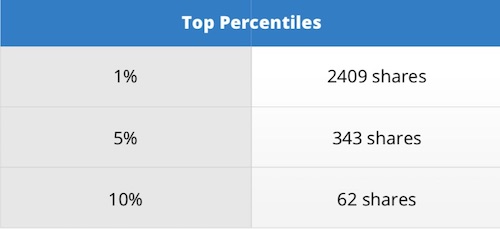BuzzSumo Director Steve Rayson today released Content Trends Report 2018, a 36-page report on the state of content marketing and how it has been promoted on social media over the past several years.
Rayson examined the social sharing and link-earning stats of 100 million posts published in 2017, and compared them to a similar sampling from 2015. His overall conclusion: “If you’re sticking with your content approach from 3 years ago, it’s now 50% less effective.”
Here are a few of the most interesting revelations from the report:
Social Sharing Is Down 50 Percent
Rayson measured the number of social shares on 100 million posts published in 2015, and then again in 2017.
He found that the median number of shares in 2015 was eight, but had fallen to four by 2017.
In 2017, 90 percent of the content sampled had fewer than 62 shares.
 2017 top 10 percent shared content
2017 top 10 percent shared contentRayson points to two other factors exacerbating this overall decline in shares per post:
- A rise in private sharing. He cited a Business Insider report showing that use of private social messaging apps has surpassed use of public social networks, and GetSocial research claiming that so-called “dark social” sharing (sharing that takes place outside of public spaces) was more than double all other sharing combined in 2017.
- Declining organic reach on Facebook. As the largest public social network by far, Facebook’s continual throttling of brand organic reach has fed the dramatic decline in social shares.
Rising Engagement Competition
As the amount of content published in most topic areas increased exponentially, the average number of shares declined.
Here is an example of a topic where the number of articles published rose steadily since 2015:

What this really means is that there is always a finite number of shares to go around for any given topic. Put another way, people will only share so much about a topic, so if the number of available articles on that topic increases, the average number of shares per post will go down.
Moreover, as the previous section demonstrated, it is likely that the lion’s share of those available shares is going to less than 10 percent of those posts.
As Rayson says in his report, “…if you enter the topic area towards the right of the chart, it is much harder to gain traction and social engagement.”
The Rich Get Richer
Rayson’s research shows that only a tiny minority of posts and sites get the vast majority of the shares for a given topic. The situation for earned backlinks is even more abysmal.
BuzzSumo data show over 70 percent of all published content never receives a single backlink.
However, some publishers buck the trend, and seem to have found a sweet spot where they consistently earn above average amounts of both shares and links for their content.
One example cited is the New York Times, which has seen the number of average shares and links actually increase over the past year.

Rayson notes that in 2017 the New York Times pursued a particular political stance in a controversial time, and at the same time carried high authority with the tribe who agreed with that stance.
The combination of a journalistic approach and high reputation and authority with a particular tribe is one way to achieve this “sweet spot” that goes counter to the overall trend, and it can be adopted by many content publishers, not just overt news sites.
If your site can establish itself in the early stages of a trending topic, as both authoritative on the topic and willing to take a stand on it, your content can buck the trend of declining shares and search engine power.
Evergreen Wins
Another type of content that seems to beat the declining social share and backlink trend is evergreen content, that is, content that continues to attract an audience long after its publication date.
While the vast majority of content gets whatever social shares and links it’s going to earn (if any) in a short time after publication, some content continues to gain both over time.
Rayson listed some common characteristics of high-performing evergreen content found in his study:
- Research-based content.
- Reference-style content (content that becomes a benchmark reference point for its topic, and is regularly updated).
- Long-life topics (topics that don’t go quickly out of style, such as “How to build the perfect team”).
- Updated content (content that is updated regularly, so readers can trust the information is not outdated).
I’ve been in charge of publishing content for my agency, since 2014, and I’ve noticed the efficacy of all of the above.
A number of our digital marketing research studies and other posts taking a strong stance on an issue in our industry, backed up with data and regularly updated, have earned evergreen status. Those posts have become a gift that keeps on giving, bringing in high levels of links, social shares, and traffic long after their initial publication.
Other Trends
Rayson’s report touches on a number of other content and sharing trends emerging from his research that we won’t detail here, but include:
- Changes in content discovery: People are accessing content in many ways now other than the big public social networks.
- Old tried-and-true hacks no longer work: Clickbait, listicles, and other staples of viral marketing have declined sharply in effectiveness, especially on Facebook.
- LinkedIn sharing: It’s actually rising.
Key Takeaways
A few of Steve Rayson’s takeaways from his data:
- Build authority and audience before the trend: When a topic like “bitcoin” gets hot, the number of articles published about it explodes. No one can read all that content, so people tend to turn first to the sites that have already established some authority on the topic.
- Forget clickbait: Don’t chase shares with so-called viral content and headlines. There is strong evidence that these practices lead to audience fatigue while bringing little business value.
- Focus on the long tail: It’s more difficult than ever to get traction on big, trending topics, unless you already have high authority in the area, as noted above. Instead, identify sub-trends early on, and start building high-quality content around them so you have a better chance of establishing authority and riding the wave to the top as it builds.
- Work on your direct distribution networks: Your customer lists, email subscribers, and other pre-engaged audiences that you can contact directly will never be subject to vagaries of social network algorithm changes and content oversaturation. Don’t abandon social, but spend more time cultivating your private audiences.
Image Credits
All charts and images copyright Steve Rayson and Buzzsumo.com, used with permission.





